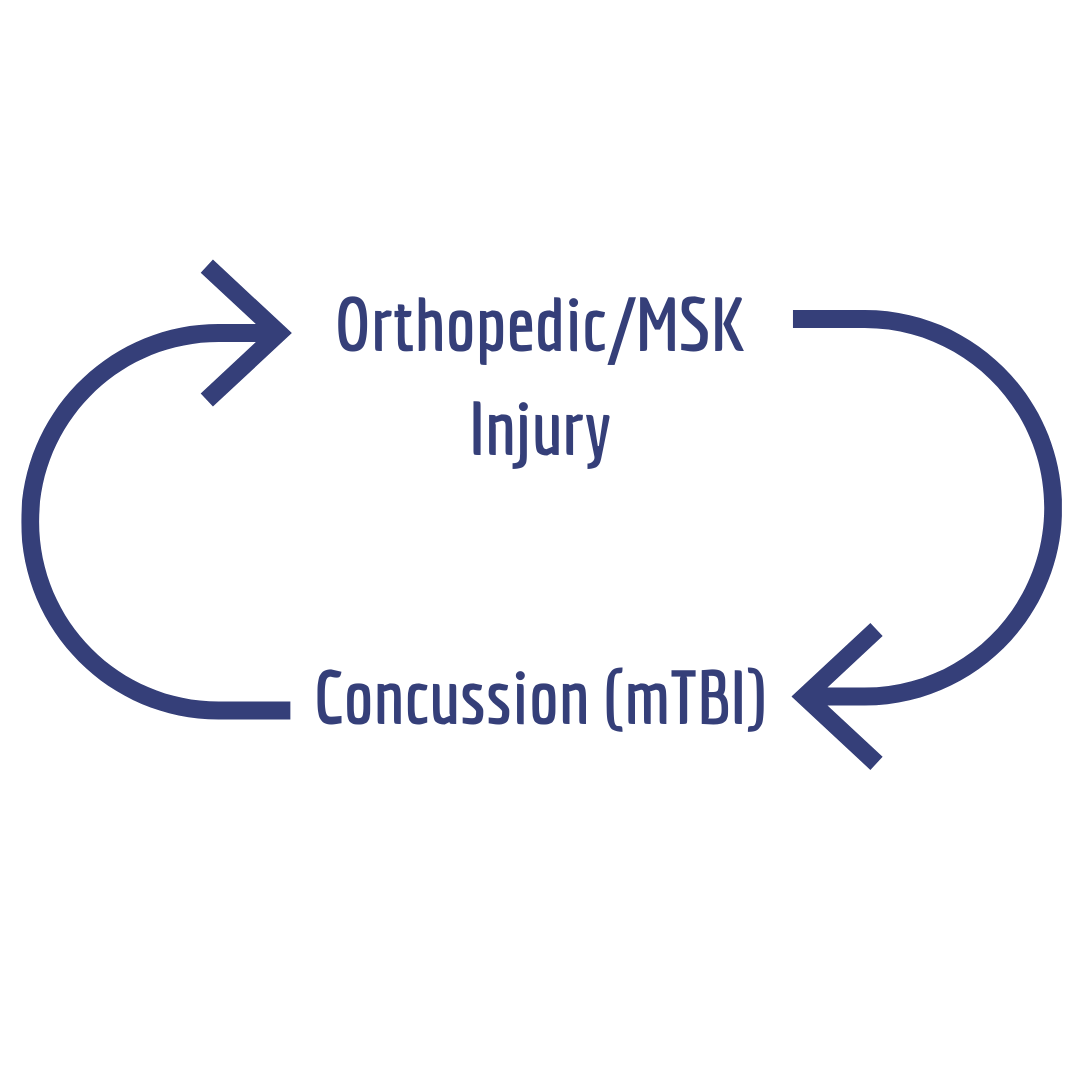Concussion may make you 2x more likely to sustain another musculoskeletal injury over the next year.
Here's the deal, more and more research is establishing that concussion places athletes, at higher risk of subsequent musculoskeletal/orthopedic injury in the following year.
Generally speaking, we're finding that risk to be about 2x higher than athletes who did not sustain a concussion. The bias of these injuries tends to favor lower body injuries:
Lateral ankle sprains
Knee injuries
Muscle strains
Etc.
*Despite this lower extremity injury bias, some studies also found upper extremity injuries to occur, as well.
This trend seems to hold from high school through college and professional levels across various contact sports.
And there seems to be a back-and-forth relationship between these concussions and orthopedic injuries. The athletes that sustained a concussion tended to have more orthopedic injuries in the year before their concussion. And the athletes that had concussions had more orthopedic injuries in the year after the concussion.
Why do we think this concussion-orthopedic injury relationship exists?
It likely has to do with neuromuscular coordination and dual-tasking deficits that last beyond symptom resolution. So, symptoms get better, but your ability to coordinate complex movement and multi-task (i.e., the demands of sport) are still impaired.
We can test dual-tasking by having you walk normally or tandem (heel-to-toe) while doing a cognitive task like saying the months of the year backward or counting down by 6's. These types of dual-tasking challenges can show deficits for up to 2 months after a concussion. And these clinical dual-task activities are not considered as difficult as navigating the fast pace of a sport like ice hockey or football. So, if we find a deficit in office, we're likely to see it on the rink, field, or court.
From a neuromuscular control perspective, we see that athletes have stiffer hips and flimsier knees and legs for up to 50 days after a concussion on a jump landing task. It also turns out that neuromuscular deficits before a concussion are a risk for concussion - just another reason you want an excellent baseline battery before the season starts. A baseline test can tell you where you're at and how you can improve.
One last point that I want to bring up is this:
Treat concussion just like you'd treat any other injury. Do it right the first time.
When you compare concussion recovery timelines to other orthopedic injuries and procedures, concussion is a relatively fast and functional injury. For example, you may be back practicing (non-contact) with your team in 1-2 weeks and back in the game between 3-6 weeks after injury. Meanwhile, when I tore my "rotator cuff," I was out for a definite 12 weeks and had lots of limited sport-specific rehab until near the end of those 12 weeks.
Takeaway points:
Concussion places you at 2x higher risk of an orthopedic injury in the coming year.
A proper concussion rehab program will be multi-modal and include dual-tasking and proprioceptively demanding activities that force you to improve your multi-tasking and neuromuscular control.
Even better than all this band-aid and repair activity is having a thorough and multi-modal baseline battery to identify these deficits before any injury occurs (e.g., "prehab").
If you "do it right the first time," your concussion rehab should be faster than many other orthopedic injuries sustained in sport.
Dr. Mark Heisig is a licensed naturopathic doctor with continuing mTBI education from The American Academy of Neurology (AAN), Complete Concussion. Management (CCMI) and The Carrick Institute. His office is located in Scottsdale, AZ.
References:
Herman, D. C., Zaremski, J. L., Vincent, H. K., & Vincent, K. R. (2015). Effect of neurocognition and concussion on musculoskeletal injury risk. Current sports medicine reports, 14(3), 194.
Howell, D. R., Bonnette, S., Diekfuss, J. A., Grooms, D. R., Myer, G. D., Wilson, J. C., & Meehan, W. P. (2020). Dual-task gait stability after concussion and subsequent injury: an exploratory investigation. Sensors, 20(21), 6297.
Howell, D. R., Lynall, R. C., Buckley, T. A., & Herman, D. C. (2018). Neuromuscular control deficits and the risk of subsequent injury after a concussion: a scoping review. Sports medicine, 48(5), 1097-1115.
McPherson, A. L., Nagai, T., Webster, K. E., & Hewett, T. E. (2019). Musculoskeletal injury risk after sport-related concussion: a systematic review and meta-analysis. The American journal of sports medicine, 47(7), 1754-1762.




